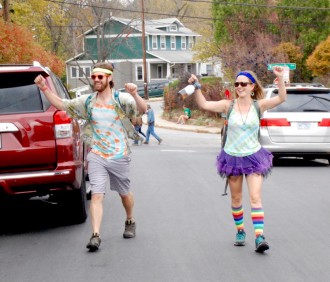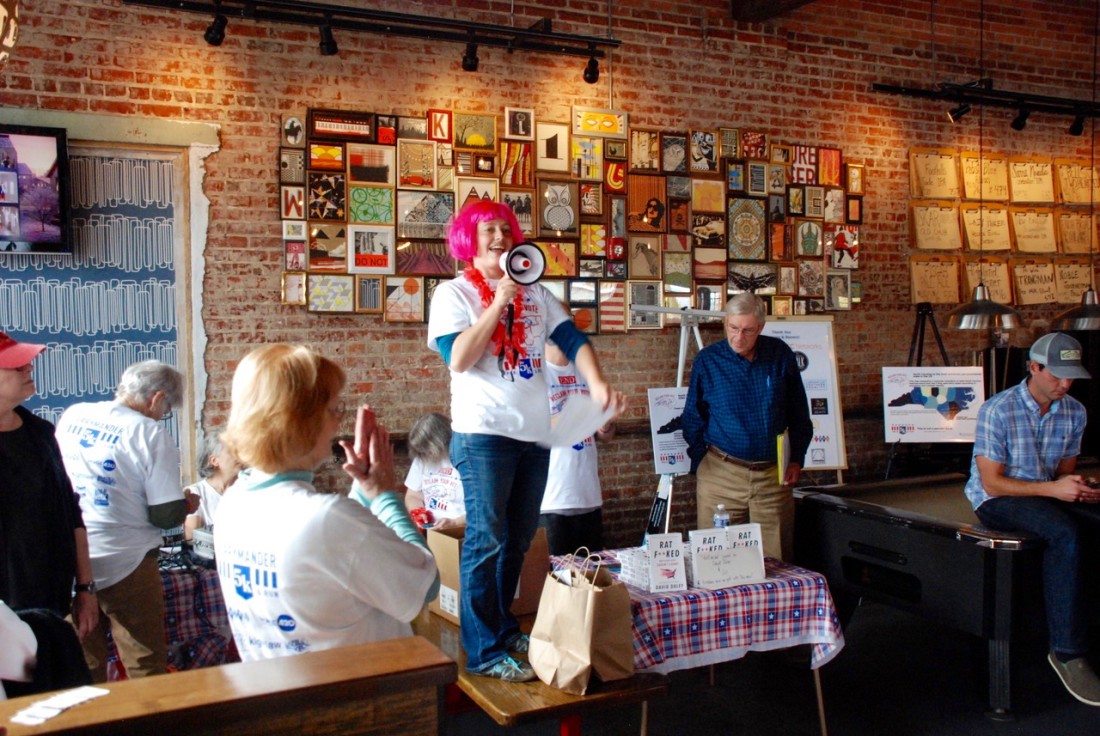Not long ago, Western North Carolina’s 11th Congressional District was disputed turf. It changed hands six times between Republicans and Democrats in the three decades after 1980. But in 2011, the N.C. General Assembly redrew the lines of the district, effectively tilting it more Republican. In the new map, the 10th District punched a fist into Asheville, absorbing half of the city into an already-conservative district and diluting Asheville’s voting power in both.
On Nov. 4, the League of Women Voters hosted a 5K in West Asheville to show what the meandering map looks like on the ground. Participants, many clad in pussy hats, colorful tutus and rainbow socks, ran and walked along a route that traced the line between the 10th and 11th districts. The route roughly followed Haywood Road and turned north at Louisiana Avenue, but it wobbled dizzily away from each.
Among the more than 350 people registered for the race was Sarah Humphries, sporting a Wonder Woman outfit for the run. She noted that the uneven district lines cause confusion. “I was voting in the last election and didn’t know which district I was in,” she explained. “So I looked on the map and noticed that I lived very close to another district, and the lines looked peculiar. I work at [UNC Asheville], and a district line cuts through a residential hall and literally splits up suitemates.”

“I feel like the voting districts are unfair and are drawn for a purposeful advantage,” Humphries added.
That advantage has helped North Carolina Republicans maintain a grip on the state’s congressional delegation. In 2016, they won 53 percent of the state’s total congressional votes and 10 of the 13 congressional races — or 77 percent.
Last year, federal courts ordered that North Carolina redraw its congressional districts — as well as its state legislative districts — by March of this year. But the district maps in question were thrown out because they relied too heavily on race. In Western North Carolina, which has electoral districts that are less diverse than elsewhere in the state, gerrymandering based on political party tends to be more of an issue than gerrymandering based on race.
While courts have ruled on race-based cases, they have so far been more willing to allow maps drawn with stilted partisan effects. That could change next year. In October, the Supreme Court heard Gill v. Whitford, in which the plaintiffs argue that Wisconsin’s maps violate the equal protection clause and their First Amendment freedom of association. If the court establishes a standard for judging partisan distortion, maps across the country will likely need adjustment.
In the meantime, candidates must run in the districts as they’re currently drawn. To that end, the Democratic candidates hoping to challenge Rep. Mark Meadows in 2018 walked the route of the Gerrymander 5K. Scott Donaldson, a urologist in Hendersonville, and Phillip Price, who owns a lumber reclamation business in Marion, spoke with participants to drum up support. Neither has held elected office before.
Price, who decided to run in response to last year’s election, thinks regional voters have been misled. “Meadows doesn’t have their interests in mind,” he says. “He votes for the wealthy, he votes for his donors. This big tax break that they’re calling a huge windfall for the middle class is a joke. And I’m sick of it, I’m sick of the bullying and the working class getting pushed further and further down, and I wanted to do something before they take everything we have left.”

After the race, both candidates schmoozed at West Asheville Lounge and Kitchen, where participants drank beer and watched a series of speeches. David Daley, author of Ratf**ked: Why Your Vote Doesn’t Count, provided the keynote. “This is one of the most gerrymandered districts in the country,” he told the crowd. “This used to be a swing district. You’ve been cracked in half.”
Daley connected gerrymandering to political polarization. “Everyone talks about partisan siloing, how nobody talks to each other anymore,” he said. “No one talks to one another because we’ve only got 35 swing districts left in the House, out of 435!”
Alana Pierce, board president of the Asheville-Buncombe County chapter of the League of Women Voters, hoped the walk would raise awareness about an otherwise abstract issue. “It’s a heady concept. It’s bureaucratic, but it really affects the fundamentals of our democracy,” she said from under a pink wig at the 5K. “This is educating people on what gerrymandering is and then how it affects your daily life.”
“When you walk the line, you can see both sides of the street and ask why this house has one representative and this house has another representative,” Pierce added. “It’s the same community. It’s the same neighborhood. So it really puts into perspective the divisions that this kind of gerrymandering creates.”




Good idea but similar events need to be organized on district lines drawn by Democrats. Until then I will have to dismiss it as partisan.
democrackkks gerrymandered NC for decades with little opposition
when we vote ‘by county’ then gerrymandering will no longer exist. easy peezy.
did the crackkks buy many of the books hawked by Mr. Daley ? the title is rather rude.
We had a great time gathering and walking with passionate folks from throughout our communities. People who are working hard to make our community a better place for all. Together we are stronger. We the people will VOTE and take back our seat in the peoples house the US HOUSE of Representatives.
Did you hear what senator comb-over said about the 78% vote “no”….. it was a sham!! Just like his hair color